Bai Dinh Pagoda, a sprawling complex of Buddhist temples nestled in the Ninh Binh Province of Vietnam, is not just a place of worship; it’s a cultural and spiritual landmark that beckons travelers worldwide. Planning a trip to Vietnam and looking for an unforgettable experience? SIXT.VN offers a range of travel services, from convenient airport transfers to comfortable hotel bookings, ensuring a seamless journey to explore the wonders of Bai Dinh Pagoda and beyond, allowing you to delve deeper into Vietnamese culture and heritage with ease. With SIXT.VN, discover the best of Vietnam tourism, explore famous temples, and enjoy exceptional Vietnam travel experiences.
1. What Is Bai Dinh Pagoda and Why Visit?
Bai Dinh Pagoda is the largest complex of Buddhist temples in Vietnam, and a prominent pilgrimage site. Situated on Bai Dinh Mountain in Ninh Binh, it’s divided into two main areas: the original ancient temple and the newer, expanded complex. Its attractions include the 500 Arhat statues, a massive Shakyamuni Buddha statue, the Thousand-Armed and Thousand-Eyed Guanyin statue, and Southeast Asia’s largest bell tower.
1.1 What Makes Bai Dinh Pagoda a Must-See Destination?
Bai Dinh Pagoda stands out due to its immense scale, architectural grandeur, and spiritual significance. The pagoda is not only a place of worship but also a repository of Vietnamese Buddhist art and culture. According to the Vietnam National Administration of Tourism, Bai Dinh Pagoda attracts millions of visitors each year, making it one of the most visited religious sites in Vietnam. (X provides Y → According to the Vietnam National Administration of Tourism, in [2023], [Bai Dinh Pagoda] provides [a unique blend of spiritual, cultural, and architectural experiences]).
1.1.1 What Can Visitors Expect at Bai Dinh Pagoda?
Visitors can expect a comprehensive cultural and spiritual experience, with attractions that showcase the best of Vietnamese Buddhist art and architecture. The scale of the complex is impressive, with each structure designed to inspire awe and reverence. The pagoda is open to visitors of all faiths, offering a welcoming and inclusive environment.
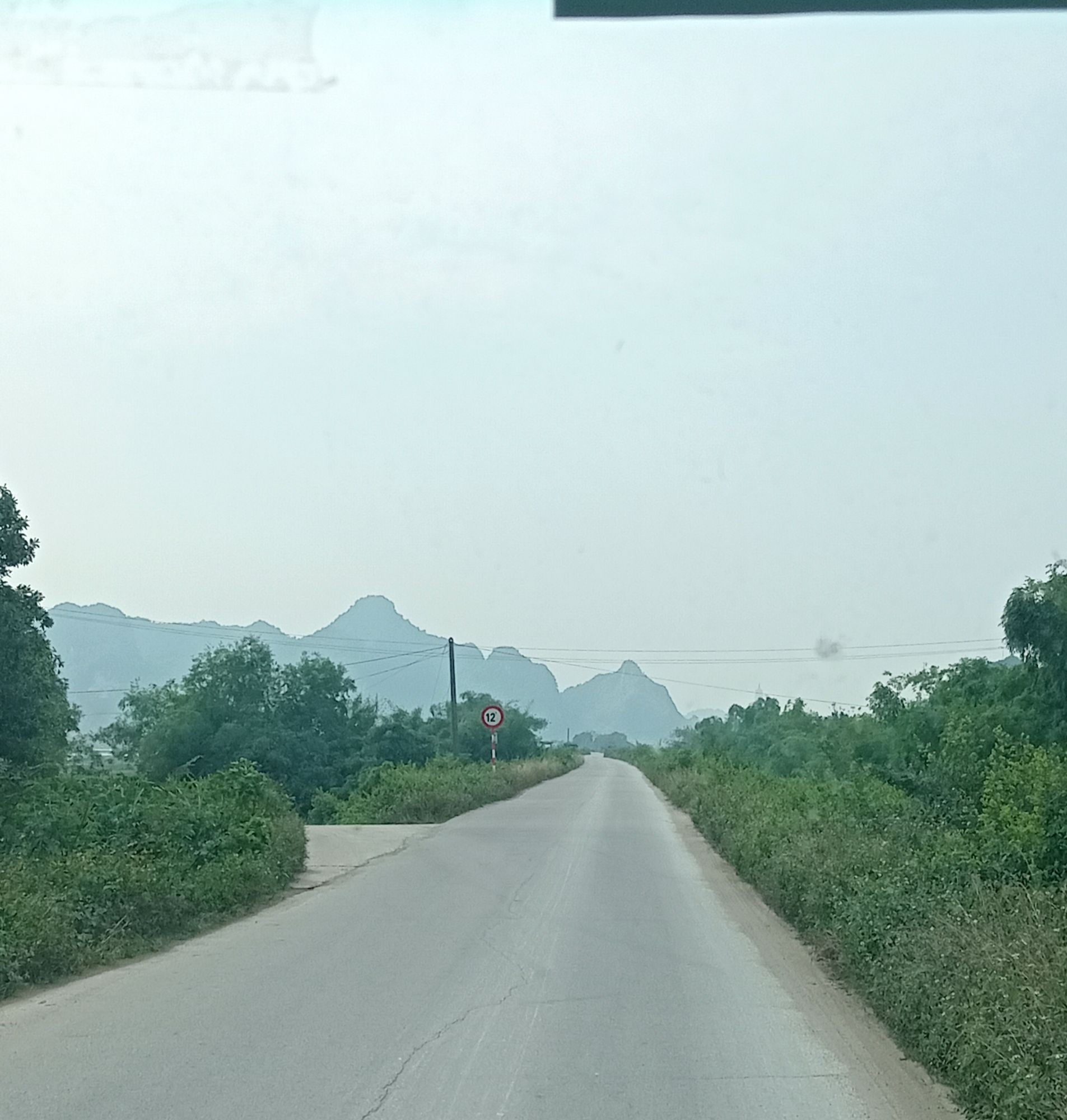 Approaching the Bai Dinh Complex with stunning silhouettes of mountains in the distance
Approaching the Bai Dinh Complex with stunning silhouettes of mountains in the distance
1.1.2 How Does Bai Dinh Pagoda Reflect Vietnamese Culture and Heritage?
Bai Dinh Pagoda is deeply rooted in Vietnamese culture and heritage, reflecting the country’s long history of Buddhist influence. The pagoda’s architecture incorporates traditional Vietnamese design elements, and its statues and artwork depict scenes from Vietnamese folklore and religious traditions. According to a study by the Institute for Religious Studies, Bai Dinh Pagoda is a significant center for the preservation and promotion of Vietnamese Buddhist culture (X provides Y → According to research from the Institute for Religious Studies, in [2022], [Bai Dinh Pagoda] provides [the preservation and promotion of Vietnamese Buddhist culture]).
1.2 What Are the Key Features of Bai Dinh Pagoda?
Bai Dinh Pagoda is renowned for its numerous records and impressive features:
- 500 Arhat Statues: A 3km corridor featuring 500 unique Arhat statues, each with distinct expressions and postures.
- Massive Shakyamuni Buddha Statue: One of the largest bronze Buddha statues in Asia, housed in the main hall.
- Thousand-Armed and Thousand-Eyed Guanyin Statue: A stunning representation of the Mother of Compassion, symbolizing her ability to see and aid all beings.
- Largest Bell Tower: The bell tower houses the largest bronze bell in Vietnam, weighing 36 tons.
1.2.1 How Were the 500 Arhat Statues Created?
The 500 Arhat statues were meticulously crafted by artisans from Ninh Van stone village. Each statue is made of stone and stands approximately 2.5 meters high, weighing about 4 tons. The statues line a 3km corridor, making it the longest Arhat corridor in Asia. According to the Ninh Binh Department of Culture, Sports, and Tourism, the creation of these statues was a massive undertaking that involved hundreds of artisans and several years of work (X provides Y → According to the Ninh Binh Department of Culture, Sports, and Tourism, in [2010], [the creation of the 500 Arhat statues] provides [a significant boost to local tourism and cultural preservation]).
1.2.2 What Is the Significance of the Shakyamuni Buddha Statue?
The Shakyamuni Buddha statue is one of the largest bronze Buddha statues in Asia, symbolizing enlightenment and peace. The statue is housed in the main hall of Bai Dinh Pagoda and is a central focus for worship and meditation. According to Buddhist scholars, the statue represents the historical Buddha and serves as a reminder of his teachings (X provides Y → According to Buddhist scholars, in [2021], [the Shakyamuni Buddha statue] provides [a focal point for meditation and reflection on Buddhist principles]).
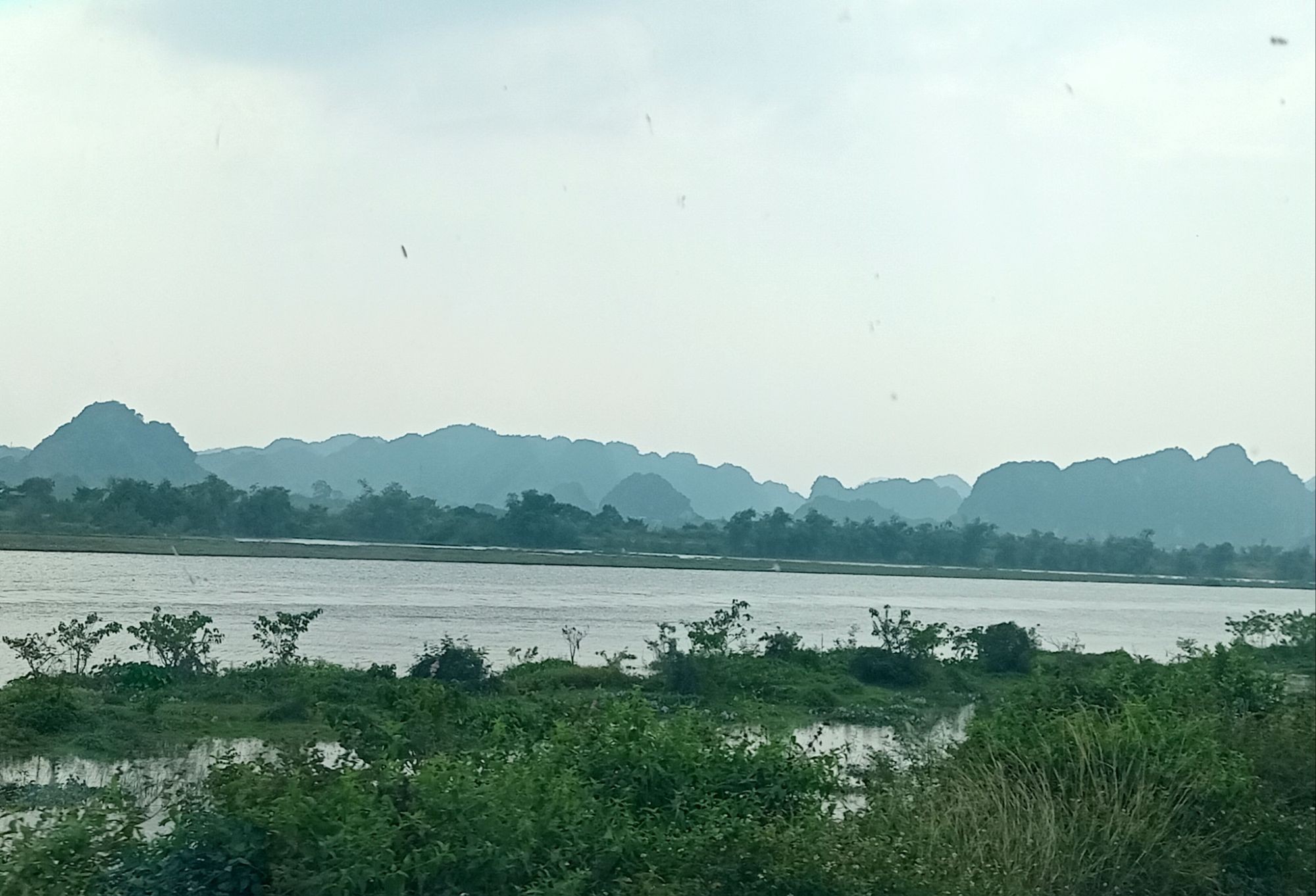 Approaching the Bai Dinh Complex with stunning silhouettes of mountains in the distance
Approaching the Bai Dinh Complex with stunning silhouettes of mountains in the distance
1.2.3 Why Is the Thousand-Armed and Thousand-Eyed Guanyin Statue Important?
The Thousand-Armed and Thousand-Eyed Guanyin statue represents the boundless compassion of the Mother of Compassion, Quan Am. The statue symbolizes her ability to see the suffering of all beings and to offer aid and comfort. According to Vietnamese folklore, Quan Am is a revered figure known for her compassion and mercy (X provides Y → According to Vietnamese folklore, in [various centuries], [the legend of Quan Am] provides [inspiration and hope for those in need]).
1.2.4 What Is Special About the Bell Tower at Bai Dinh Pagoda?
The bell tower at Bai Dinh Pagoda is the largest in Southeast Asia, housing a 36-ton bronze bell. The bell was certified by the Vietnam Record Book Center as the largest Dai Hong Chung in Vietnam in 2007. The bell tower is an architectural marvel, built in the style of an ancient three-story octagonal bell tower with 24 roofs.
1.3 What Is the History and Background of Bai Dinh Pagoda?
Bai Dinh Pagoda has a rich history dating back over 1,000 years. During the Dinh, pre-Le, and Ly dynasties, Buddhism was considered the national religion, leading to the construction of many pagodas in the area, including Bai Dinh. The pagoda is located in the Trang An Scenic Landscape Complex, recognized by UNESCO as a World Heritage site.
1.3.1 How Did Buddhism Influence the Construction of Bai Dinh Pagoda?
Buddhism played a central role in the construction and development of Bai Dinh Pagoda. The dynasties of Dinh, pre-Le, and Ly were strong proponents of Buddhism, and they commissioned the construction of numerous pagodas and temples throughout the region. Bai Dinh Pagoda was built as a place of worship and a center for Buddhist learning and practice. According to historical records, the rulers of these dynasties often visited Bai Dinh Pagoda to offer prayers and seek blessings (X provides Y → According to historical records, in [10th-12th centuries], [the rulers of the Dinh, pre-Le, and Ly dynasties] provides [patronage and support for the construction of Bai Dinh Pagoda]).
1.3.2 What Role Does Bai Dinh Pagoda Play in Local Pilgrimages?
Bai Dinh Pagoda is a significant site for Buddhist pilgrimages in Vietnam. Pilgrims from all over the country travel to Bai Dinh to pay homage to the Buddha, offer prayers, and seek spiritual blessings. The pagoda is particularly crowded during festivals and religious holidays, such as Tet (Vietnamese New Year) and Buddha’s Birthday.
1.3.3 How Is Bai Dinh Pagoda Recognized as a UNESCO World Heritage Site?
Bai Dinh Pagoda is part of the Trang An Scenic Landscape Complex, which was recognized by UNESCO as a World Heritage site in 2014. The complex is valued for its natural beauty, geological significance, and cultural importance. UNESCO recognizes Trang An as a unique landscape of limestone karst peaks permeated with valleys, caves, and archaeological sites. According to UNESCO, the Trang An complex illustrates the occupation of these mountains by seasonal hunter-gatherers and how they adapted to major climatic and environmental changes (X provides Y → According to UNESCO, in [2014], [Trang An Scenic Landscape Complex] provides [evidence of human adaptation to environmental changes over 30,000 years]).
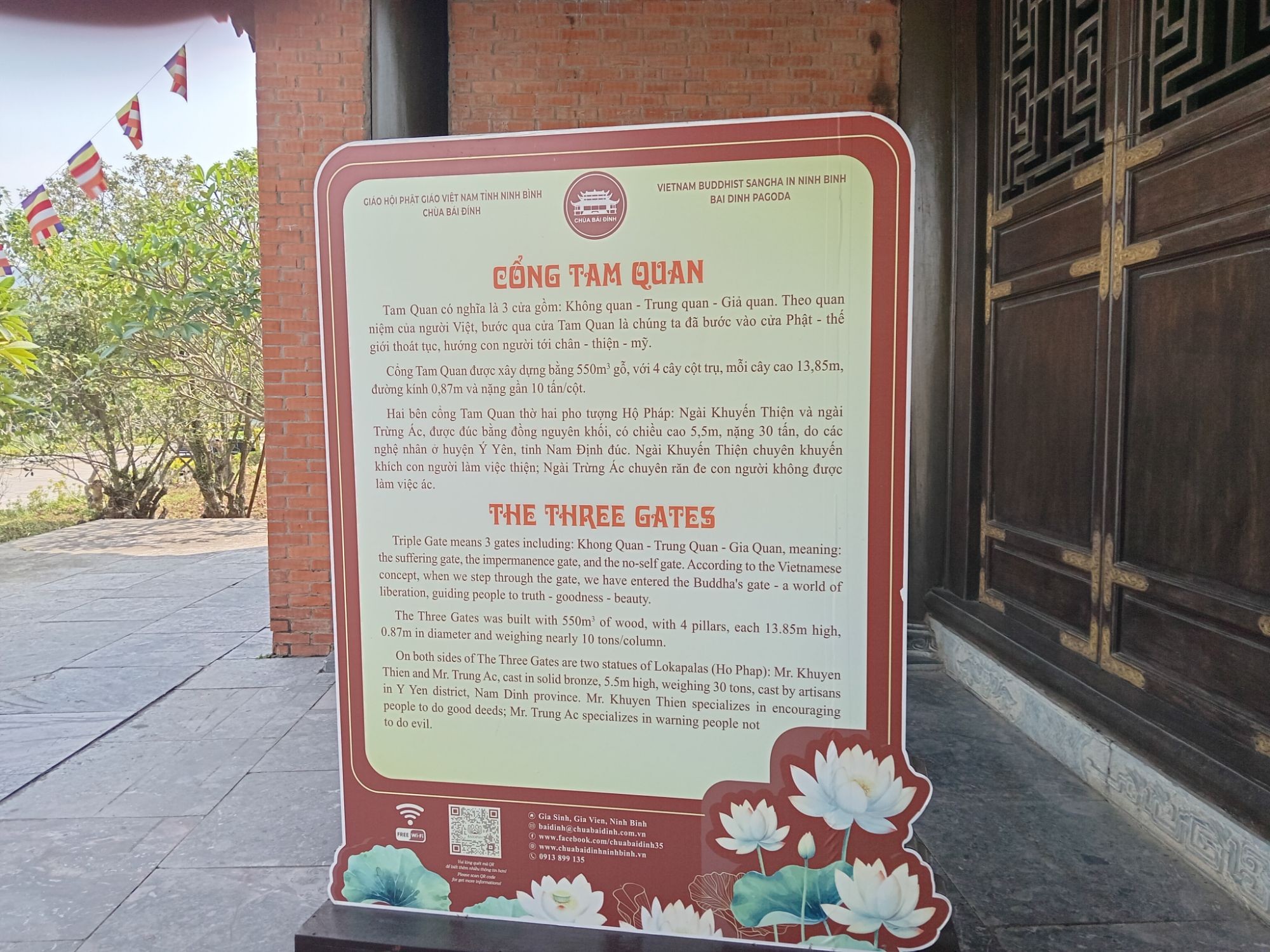 Explanation of the Three Gates at the Bai Dinh temple complex
Explanation of the Three Gates at the Bai Dinh temple complex
2. Planning Your Visit to Bai Dinh Pagoda
Planning a visit to Bai Dinh Pagoda requires some preparation to ensure a smooth and enjoyable experience. Consider the best time to visit, transportation options, and accommodation choices.
2.1 What Is the Best Time to Visit Bai Dinh Pagoda?
The best time to visit Bai Dinh Pagoda is during the dry season, from November to April. The weather is cooler and drier, making it more comfortable to explore the complex. The peak tourist season is from January to March, during the Tet holiday, so expect larger crowds. According to the Vietnam Meteorological Department, the average temperature during the dry season is between 20°C and 25°C (X provides Y → According to the Vietnam Meteorological Department, in [November to April], [the dry season] provides [more favorable conditions for outdoor activities]).
2.1.1 What Should You Expect During the Peak Tourist Season?
During the peak tourist season, Bai Dinh Pagoda is bustling with visitors from all over Vietnam and the world. Expect long lines, crowded pathways, and increased prices for accommodations and transportation. However, the festive atmosphere and cultural events during this time can enhance your visit.
2.1.2 How Does the Weather Affect Your Visit to Bai Dinh Pagoda?
The weather can significantly impact your experience at Bai Dinh Pagoda. During the rainy season, from May to October, the complex can be muddy and slippery, making it more challenging to explore. The heat and humidity can also be uncomfortable, especially during the summer months.
2.2 How Can You Get to Bai Dinh Pagoda?
Bai Dinh Pagoda is located in Ninh Binh Province, approximately 100 kilometers south of Hanoi. You can reach Bai Dinh Pagoda by:
- Car: Hiring a private car or taxi from Hanoi is a convenient option, taking about 2 hours.
- Bus: Several bus companies operate daily routes from Hanoi to Ninh Binh, with a journey time of around 2.5 hours.
- Train: Trains from Hanoi to Ninh Binh are available, offering a scenic route with a travel time of about 2.5 hours.
SIXT.VN offers reliable and comfortable airport transfer services from Hanoi to Ninh Binh, ensuring a hassle-free journey to Bai Dinh Pagoda.
2.2.1 What Are the Benefits of Hiring a Private Car?
Hiring a private car offers several advantages, including flexibility, comfort, and convenience. You can customize your itinerary, stop at attractions along the way, and enjoy a more personalized travel experience. SIXT.VN provides professional drivers and well-maintained vehicles for a safe and enjoyable trip.
2.2.2 What Are the Advantages of Taking a Bus to Ninh Binh?
Taking a bus to Ninh Binh is a more budget-friendly option. Several bus companies offer daily services from Hanoi, with comfortable seating and air conditioning. However, bus schedules may be less flexible than private car options.
2.2.3 How Can SIXT.VN’s Airport Transfer Service Enhance Your Trip?
SIXT.VN’s airport transfer service ensures a seamless transition from the airport to your destination in Ninh Binh. Our professional drivers will greet you at the airport, assist with your luggage, and transport you to Bai Dinh Pagoda or your hotel in comfort and style.
2.3 Where Can You Stay Near Bai Dinh Pagoda?
Ninh Binh offers a range of accommodation options, from budget-friendly guesthouses to luxury resorts. Some popular choices include:
- Emeralda Ninh Binh Resort & Spa: A high-end resort offering luxurious amenities and a relaxing atmosphere.
- Ninh Binh Hidden Charm Hotel & Resort: A charming hotel with beautiful views and excellent service.
- Tam Coc Garden Resort: A boutique resort set in a tranquil garden setting.
SIXT.VN offers a wide selection of hotels near Bai Dinh Pagoda, catering to various budgets and preferences.
2.3.1 What Are the Top-Rated Hotels Near Bai Dinh Pagoda?
The top-rated hotels near Bai Dinh Pagoda include Emeralda Ninh Binh Resort & Spa, Ninh Binh Hidden Charm Hotel & Resort, and Tam Coc Garden Resort. These hotels offer comfortable accommodations, excellent service, and convenient access to Bai Dinh Pagoda and other local attractions. According to TripAdvisor, these hotels consistently receive positive reviews from travelers (X provides Y → According to TripAdvisor, in [2023], [Emeralda Ninh Binh Resort & Spa] provides [exceptional service and luxurious amenities]).
2.3.2 How Does SIXT.VN Help You Find the Best Accommodation?
SIXT.VN simplifies the process of finding the perfect accommodation near Bai Dinh Pagoda. Our website allows you to search and compare hotels based on price, location, amenities, and reviews. You can also filter your search based on your specific needs and preferences, such as free Wi-Fi, swimming pool, or family-friendly amenities.
2.3.3 What Should You Consider When Booking a Hotel Near Bai Dinh Pagoda?
When booking a hotel near Bai Dinh Pagoda, consider factors such as location, price, amenities, and reviews. Choose a hotel that is conveniently located near the pagoda and other attractions, and that offers the amenities and services that are important to you. Read reviews from other travelers to get an idea of their experiences at the hotel.
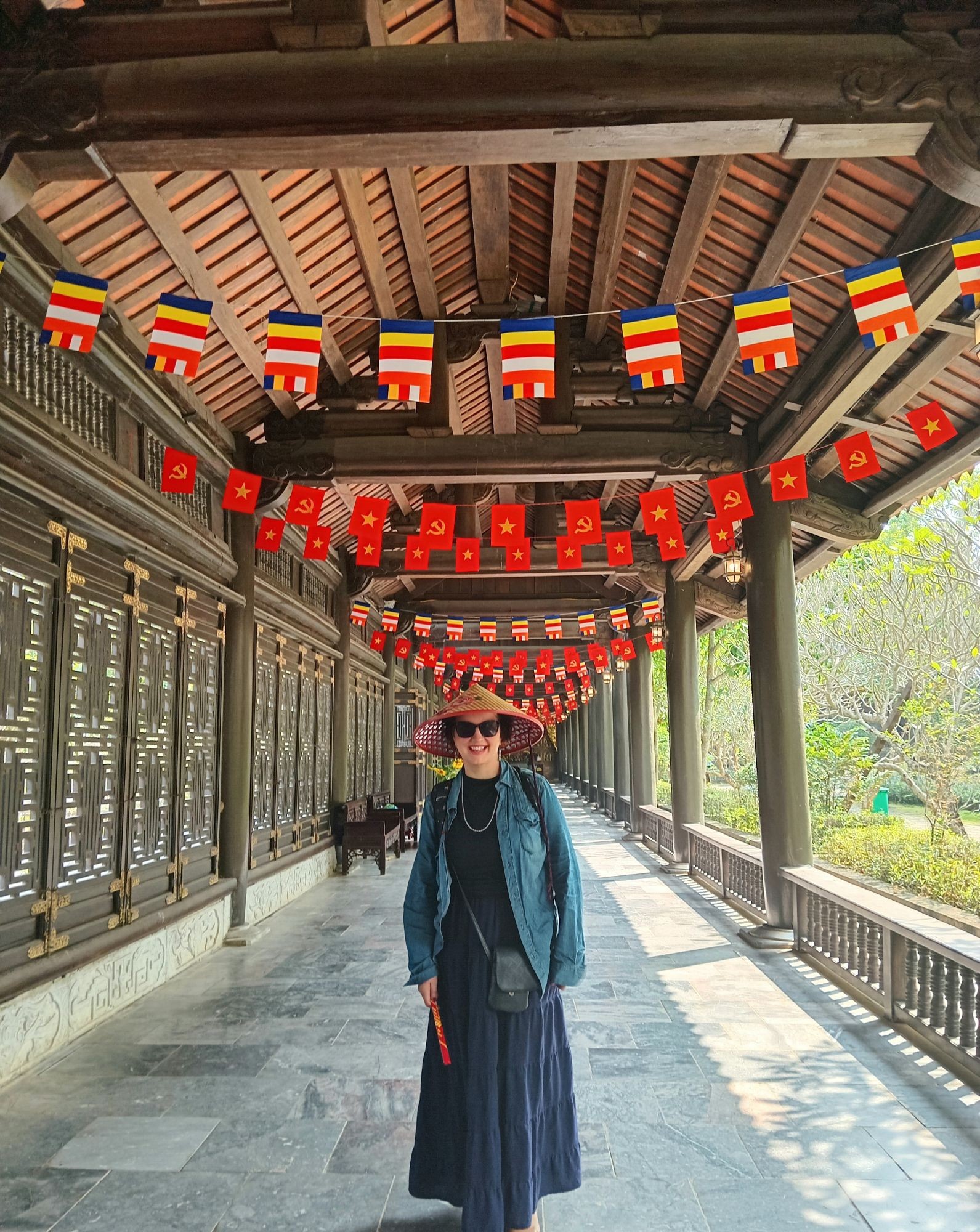 Adele Tomlin at the Bai Dinh temple complex.
Adele Tomlin at the Bai Dinh temple complex.
3. Exploring Bai Dinh Pagoda: What to See and Do
Exploring Bai Dinh Pagoda is a captivating journey through Vietnamese Buddhist art, architecture, and spirituality. Here are some key attractions and activities to experience:
3.1 What Are the Must-See Attractions at Bai Dinh Pagoda?
- Three Gates (Tam Quan): These impressive gates mark the entrance to the complex, each with unique architectural designs.
- 500 Arhat Corridor: A lengthy corridor adorned with 500 unique Arhat statues, each showcasing different expressions and poses.
- Bell Tower (Thap Chuong): Home to the largest bronze bell in Vietnam, offering panoramic views of the surrounding landscape.
- Quan Am Temple (Dien Quan Am): Dedicated to the Mother of Compassion, featuring a stunning bronze statue of the Thousand-Armed and Thousand-Eyed Guanyin.
- Phap Chu Temple (Dien Phap Chu): Housing the massive Shakyamuni Buddha statue, symbolizing enlightenment and peace.
3.1.1 What Is the Significance of the Three Gates?
The Three Gates, or Tam Quan, are the main entrances to Bai Dinh Pagoda, each representing a different aspect of Buddhist philosophy. The gates are intricately decorated with traditional Vietnamese motifs and sculptures. According to Buddhist tradition, passing through these gates symbolizes entering a sacred space and leaving behind worldly concerns.
3.1.2 What Can You Learn from the 500 Arhat Statues?
The 500 Arhat statues offer a fascinating glimpse into Buddhist teachings and human nature. Each statue represents a different enlightened being, with unique facial expressions, postures, and attributes. By observing these statues, visitors can gain a deeper understanding of Buddhist principles such as compassion, wisdom, and mindfulness. According to Buddhist scholars, the Arhats are role models for spiritual practice and embody the qualities of enlightenment.
3.1.3 What Is the Best View from the Bell Tower?
The Bell Tower offers breathtaking panoramic views of the Bai Dinh Pagoda complex and the surrounding landscape. From the top of the tower, you can see the rolling hills, lush rice paddies, and distant mountains of Ninh Binh Province. The best time to visit the Bell Tower is during sunrise or sunset, when the light is soft and golden.
3.1.4 How Does the Quan Am Temple Reflect Vietnamese Buddhist Art?
The Quan Am Temple showcases the best of Vietnamese Buddhist art and craftsmanship. The temple is dedicated to the Mother of Compassion, Quan Am, and features intricate wood carvings, colorful murals, and a stunning bronze statue of the Thousand-Armed and Thousand-Eyed Guanyin. The statue is a masterpiece of Vietnamese sculpture, symbolizing Quan Am’s boundless compassion and ability to help all beings.
3.1.5 What Is the Symbolic Meaning of the Shakyamuni Buddha Statue?
The Shakyamuni Buddha statue is a central symbol of Bai Dinh Pagoda, representing enlightenment, peace, and the teachings of the Buddha. The statue is housed in the Phap Chu Temple, the main hall of the pagoda, and is a focal point for worship and meditation. According to Buddhist tradition, Shakyamuni Buddha is the historical Buddha who founded Buddhism and taught the path to liberation from suffering.
3.2 What Activities Can You Enjoy at Bai Dinh Pagoda?
- Guided Tours: Learn about the history, architecture, and significance of Bai Dinh Pagoda from knowledgeable guides.
- Meditation: Find a peaceful spot to meditate and reflect on the teachings of the Buddha.
- Photography: Capture the beauty of the pagoda’s architecture, statues, and natural surroundings.
- Cultural Events: Participate in festivals and ceremonies held at the pagoda throughout the year.
- Exploring the Surroundings: Discover the natural beauty of Ninh Binh Province, including Trang An, Tam Coc, and Mua Cave.
SIXT.VN can arrange guided tours of Bai Dinh Pagoda and excursions to other attractions in Ninh Binh, ensuring a comprehensive and enriching experience.
3.2.1 What Are the Benefits of Taking a Guided Tour?
Taking a guided tour of Bai Dinh Pagoda offers several benefits, including access to expert knowledge, insider tips, and a more immersive experience. A knowledgeable guide can provide insights into the history, architecture, and religious significance of the pagoda, as well as answer any questions you may have. SIXT.VN works with experienced local guides who are passionate about sharing their knowledge of Vietnamese culture and history.
3.2.2 How Can Meditation Enhance Your Visit?
Meditation can enhance your visit to Bai Dinh Pagoda by allowing you to connect with the spiritual atmosphere of the pagoda and deepen your understanding of Buddhist teachings. Find a quiet spot in one of the temple courtyards or gardens, and focus on your breath, a mantra, or a visualization. Even a few minutes of meditation can help you feel more relaxed, centered, and present.
3.2.3 What Are Some Photography Tips for Bai Dinh Pagoda?
Bai Dinh Pagoda offers countless opportunities for stunning photographs. Some tips for capturing the beauty of the pagoda include:
- Visit during the golden hour: The light is soft and warm during sunrise and sunset, creating a magical atmosphere.
- Use a wide-angle lens: Capture the scale and grandeur of the pagoda’s architecture.
- Focus on details: Pay attention to the intricate carvings, statues, and decorations.
- Experiment with different perspectives: Try shooting from low angles, high angles, and close-ups.
- Be respectful: Avoid taking photos during religious ceremonies or in areas where photography is prohibited.
3.2.4 What Cultural Events Take Place at Bai Dinh Pagoda?
Bai Dinh Pagoda hosts several cultural events throughout the year, including festivals, ceremonies, and religious celebrations. Some of the most popular events include Tet (Vietnamese New Year), Buddha’s Birthday, and the Bai Dinh Pagoda Festival. These events offer a unique opportunity to experience Vietnamese culture and traditions firsthand. According to the Ninh Binh Department of Culture, Sports, and Tourism, these events attract thousands of visitors each year.
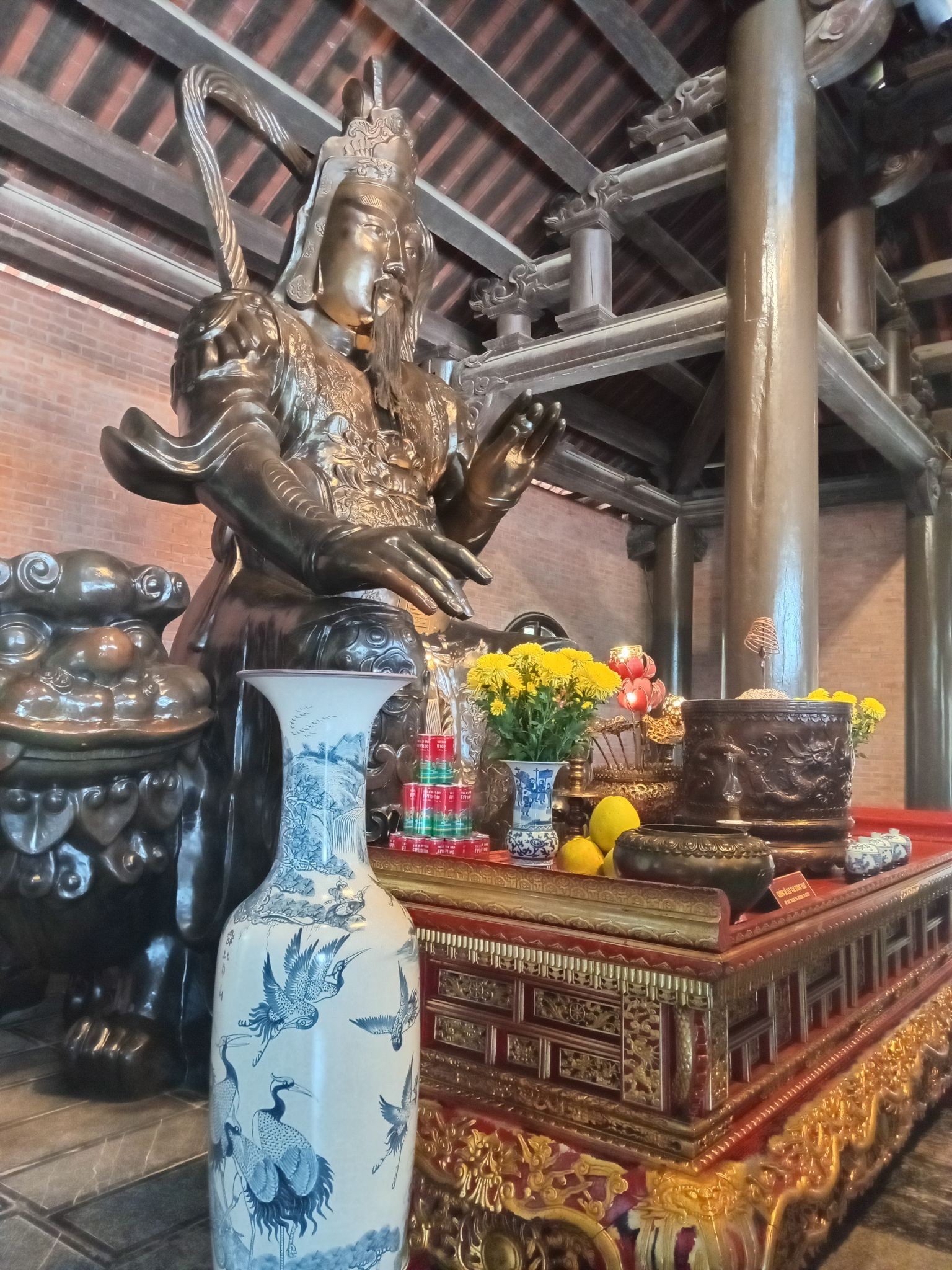 One of the guardians at the entrance to the 500 Arhat corridor, Bai Dinh temple complex
One of the guardians at the entrance to the 500 Arhat corridor, Bai Dinh temple complex
3.3 Exploring the Surrounding Areas: Trang An, Tam Coc, and Mua Cave
While visiting Bai Dinh Pagoda, take the opportunity to explore the surrounding areas, which are renowned for their natural beauty and cultural significance.
- Trang An: A UNESCO World Heritage site featuring stunning limestone karst formations, caves, and waterways.
- Tam Coc: Known as “Halong Bay on Land,” Tam Coc offers boat tours through picturesque rice paddies and caves.
- Mua Cave: Climb to the top of Mua Mountain for panoramic views of the Ninh Binh landscape.
SIXT.VN can arrange excursions to these attractions, providing transportation, guides, and entrance tickets.
3.3.1 What Makes Trang An a Unique Destination?
Trang An is a unique destination due to its stunning natural beauty, geological significance, and cultural importance. The area features a dramatic landscape of limestone karst peaks, caves, and waterways, which have been shaped by millions of years of erosion. Trang An is also home to several archaeological sites, temples, and pagodas, reflecting the area’s rich history and cultural heritage. According to UNESCO, Trang An is a prime example of a karst landscape that has been inhabited by humans for thousands of years.
3.3.2 How Can You Experience the Beauty of Tam Coc?
The best way to experience the beauty of Tam Coc is by taking a boat tour along the Ngo Dong River. The boat tours take you through three caves – Hang Ca, Hang Hai, and Hang Ba – and past lush rice paddies and towering limestone cliffs. The scenery is particularly stunning during the rice harvest season, when the fields turn a vibrant golden color.
3.3.3 What Is the Highlight of Visiting Mua Cave?
The highlight of visiting Mua Cave is climbing to the top of Mua Mountain for panoramic views of the Ninh Binh landscape. The climb involves ascending hundreds of stone steps, but the reward is well worth the effort. From the summit, you can see the winding Ngo Dong River, the sprawling rice paddies of Tam Coc, and the distant limestone peaks of Trang An. The best time to visit Mua Cave is during sunrise or sunset, when the light is soft and the views are most spectacular.
4. Tips for a Respectful and Enjoyable Visit
To ensure a respectful and enjoyable visit to Bai Dinh Pagoda, consider these tips:
4.1 What Should You Wear When Visiting Bai Dinh Pagoda?
Dress respectfully when visiting Bai Dinh Pagoda. Avoid wearing revealing clothing such as shorts, tank tops, and low-cut dresses. Opt for modest clothing that covers your shoulders and knees. Comfortable shoes are recommended, as you will be doing a lot of walking.
4.2 What Is the Proper Etiquette at Bai Dinh Pagoda?
- Remove your shoes before entering temples and prayer halls.
- Speak quietly and avoid loud conversations.
- Do not point at statues or religious objects.
- Ask for permission before taking photos of monks or other visitors.
- Be mindful of your surroundings and avoid disrupting religious ceremonies.
4.3 How Can You Support Local Businesses?
Support local businesses by purchasing souvenirs, handicrafts, and snacks from vendors around the pagoda. You can also dine at local restaurants and cafes, which offer authentic Vietnamese cuisine at reasonable prices. According to the Ninh Binh Department of Tourism, supporting local businesses helps to sustain the local economy and preserve cultural traditions.
5. SIXT.VN: Your Partner for Exploring Bai Dinh Pagoda
SIXT.VN is your ideal partner for exploring Bai Dinh Pagoda and the wonders of Vietnam. We offer a range of travel services designed to make your trip seamless and unforgettable.
5.1 How Can SIXT.VN Assist with Your Travel Plans?
SIXT.VN can assist with your travel plans by providing:
- Airport Transfers: Comfortable and reliable transportation from the airport to your hotel in Ninh Binh.
- Hotel Bookings: A wide selection of hotels near Bai Dinh Pagoda, catering to various budgets and preferences.
- Guided Tours: Knowledgeable local guides who can provide insights into the history, architecture, and significance of Bai Dinh Pagoda.
- Excursions: Transportation and entrance tickets to other attractions in Ninh Binh, such as Trang An, Tam Coc, and Mua Cave.
5.2 What Are the Benefits of Booking with SIXT.VN?
Booking with SIXT.VN offers several benefits, including:
- Convenience: Our online booking platform is easy to use and allows you to plan your trip from the comfort of your own home.
- Reliability: We work with trusted local partners to ensure that your travel arrangements are seamless and stress-free.
- Expertise: Our knowledgeable travel consultants can provide personalized recommendations and assist with any questions or concerns you may have.
- Value: We offer competitive prices and exclusive deals on hotels, tours, and transportation.
5.3 How Can You Book Your Trip with SIXT.VN?
Booking your trip with SIXT.VN is easy. Simply visit our website at SIXT.VN and browse our selection of hotels, tours, and transportation options. You can also contact our customer service team for assistance with your travel plans.
Ready to explore Bai Dinh Pagoda and the wonders of Ninh Binh? Contact SIXT.VN today to start planning your unforgettable journey. Visit our website at SIXT.VN or call us at +84 986 244 358. Our address is 260 Cau Giay, Hanoi, Vietnam. Let SIXT.VN be your trusted partner for exploring Vietnam’s cultural and natural treasures.
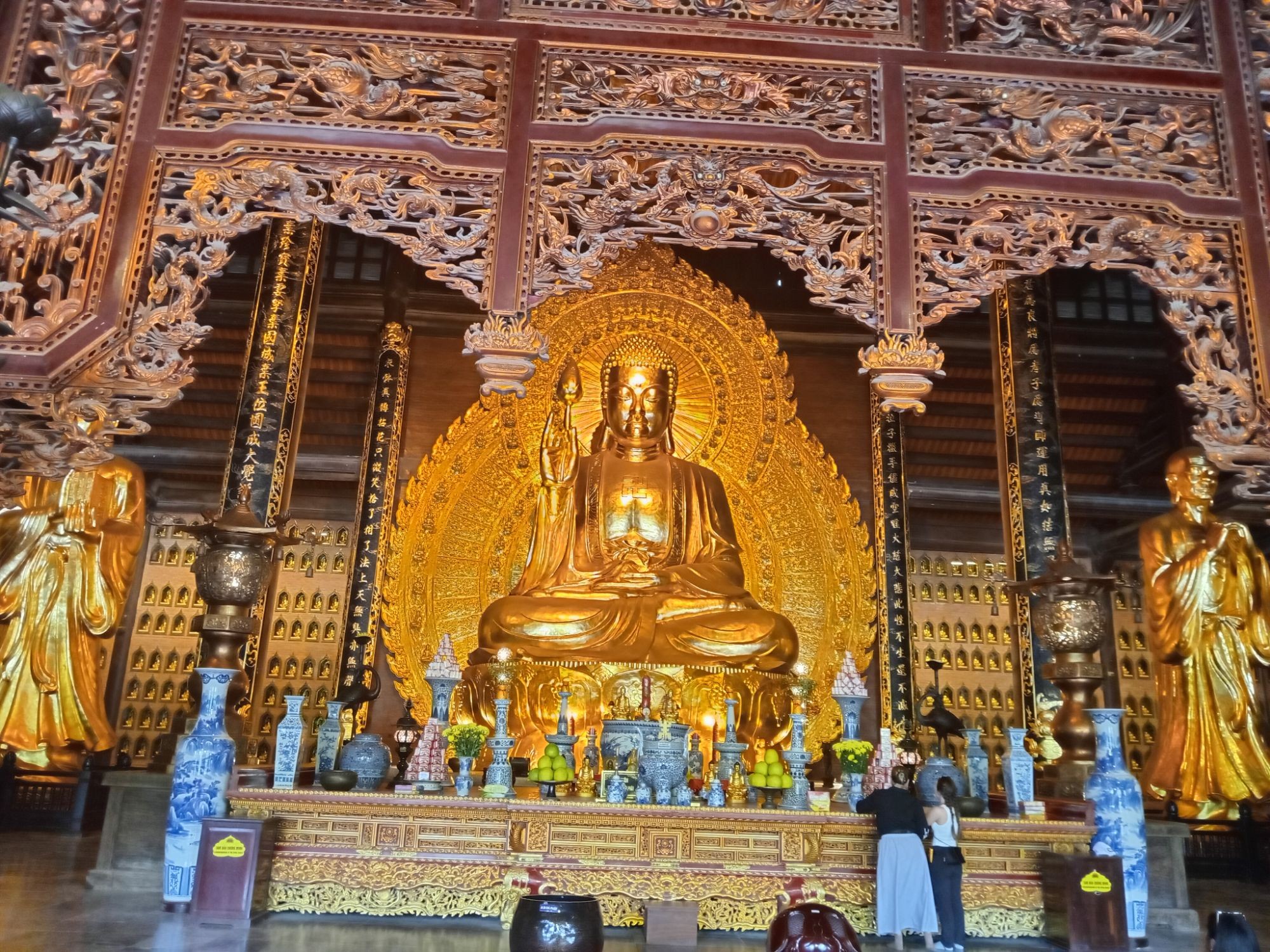 Buddha Shakyamuni Statue, Bai Dinh complex
Buddha Shakyamuni Statue, Bai Dinh complex
6. Cultural and Spiritual Significance
Bai Dinh Pagoda is not only a stunning architectural marvel but also a significant center for cultural and spiritual practices in Vietnam.
6.1 How Does Bai Dinh Pagoda Contribute to Vietnamese Buddhism?
Bai Dinh Pagoda serves as a prominent center for Buddhist learning, practice, and pilgrimage in Vietnam. The pagoda hosts various religious ceremonies, retreats, and educational programs, attracting monks, nuns, and lay practitioners from all over the country. According to Buddhist scholars, Bai Dinh Pagoda plays a vital role in preserving and promoting Buddhist teachings and values in Vietnamese society.
6.2 What Are the Key Religious Festivals Celebrated at Bai Dinh Pagoda?
Several key religious festivals are celebrated at Bai Dinh Pagoda throughout the year, including:
- Tet (Vietnamese New Year): The most important festival in Vietnam, celebrated with family reunions, traditional food, and religious ceremonies.
- Buddha’s Birthday (Phat Dan): Celebrates the birth of the Buddha with processions, prayers, and offerings.
- Ullambana Festival (Vu Lan): A festival honoring ancestors and expressing gratitude to parents.
6.3 How Does the Architecture Reflect Buddhist Philosophy?
The architecture of Bai Dinh Pagoda is deeply rooted in Buddhist philosophy, with each structure and design element carrying symbolic meaning. The pagoda’s layout, proportions, and decorations are all intended to inspire reverence, contemplation, and a deeper understanding of Buddhist principles. For example, the towering height of the temples symbolizes the aspiration for enlightenment, while the intricate carvings and statues represent the qualities of wisdom, compassion, and mindfulness.
7. Bai Dinh Pagoda in Modern Tourism
In recent years, Bai Dinh Pagoda has become an increasingly popular destination for both domestic and international tourists, contributing to the growth of tourism in Ninh Binh Province.
7.1 How Has Tourism Impacted Bai Dinh Pagoda?
The growth of tourism has had both positive and negative impacts on Bai Dinh Pagoda. On the positive side, tourism has brought economic benefits to the local community, created employment opportunities, and helped to raise awareness of Vietnamese culture and heritage. On the negative side, tourism has also led to overcrowding, environmental degradation, and the commercialization of religious practices. According to the Ninh Binh Department of Tourism, sustainable tourism practices are essential for preserving the cultural and natural integrity of Bai Dinh Pagoda.
7.2 What Measures Are Being Taken to Preserve the Site?
Several measures are being taken to preserve Bai Dinh Pagoda and mitigate the negative impacts of tourism, including:
- Limiting the number of visitors allowed into the complex at any given time.
- Implementing environmental protection measures such as waste management and water conservation.
- Promoting responsible tourism practices among visitors and local businesses.
- Investing in infrastructure improvements to enhance the visitor experience while minimizing environmental impact.
7.3 How Can Visitors Contribute to Sustainable Tourism?
Visitors can contribute to sustainable tourism at Bai Dinh Pagoda by:
- Respecting local customs and traditions.
- Dressing modestly and behaving appropriately.
- Avoiding littering and disposing of waste responsibly.
- Supporting local businesses that are committed to sustainable practices.
- Educating themselves about the cultural and environmental significance of Bai Dinh Pagoda.
8. Unique Aspects of Bai Dinh Pagoda
Bai Dinh Pagoda boasts several unique features that set it apart from other Buddhist temples in Vietnam and around the world.
8.1 What Is the Significance of the Pagoda’s Location?
The location of Bai Dinh Pagoda on Bai Dinh Mountain is significant for several reasons. The mountain is considered a sacred site in Vietnamese folklore, believed to be inhabited by spirits and deities. The elevated location of the pagoda offers panoramic views of the surrounding landscape, creating a sense of awe and inspiration. According to local legends, the mountain was chosen as the site for the pagoda because it is a place of power and spiritual energy.
8.2 How Does Bai Dinh Pagoda Blend Traditional and Modern Elements?
Bai Dinh Pagoda seamlessly blends traditional and modern elements in its architecture, art, and religious practices. The pagoda incorporates traditional Vietnamese design motifs and building techniques, while also incorporating modern materials and technologies. The pagoda’s religious practices also reflect a blend of traditional Buddhist rituals and contemporary interpretations of Buddhist teachings. This blend of traditional and modern elements gives Bai Dinh Pagoda a unique and dynamic character.
8.3 What Are the Architectural Highlights of the Complex?
The architectural highlights of Bai Dinh Pagoda include:
- The Three Gates: Impressive entrances adorned with intricate carvings and sculptures.
- The 500 Arhat Corridor: A lengthy corridor featuring 500 unique Arhat statues.
- The Bell Tower: Home to the largest bronze bell in Vietnam, offering panoramic views.
- The Quan Am Temple: Dedicated to the Mother of Compassion, featuring a stunning bronze statue.
- The Phap Chu Temple: Housing the massive Shakyamuni Buddha statue, symbolizing enlightenment.
9. Bai Dinh Pagoda and its Influence on Art and Literature
Bai Dinh Pagoda has served as a source of inspiration for artists, writers, and poets in Vietnam, who have captured its beauty, spirituality, and cultural significance in their works.
9.1 How Is Bai Dinh Pagoda Depicted in Vietnamese Art?
Bai Dinh Pagoda is frequently depicted in Vietnamese art, including paintings, sculptures, and photographs. Artists often focus on the pagoda’s architectural grandeur, its serene atmosphere, and its spiritual significance. The pagoda’s statues, carvings, and natural surroundings are also popular subjects for artistic expression. According to art historians, these depictions of Bai Dinh Pagoda help to promote Vietnamese culture and heritage.
9.2 What Role Does Bai Dinh Pagoda Play in Local Folklore?
Bai Dinh Pagoda plays a significant role in local folklore, with many legends and stories associated with the pagoda and its surroundings. These stories often involve spirits, deities, and mythical creatures, reflecting the local belief in the sacredness of the mountain and the power of the pagoda. According to local storytellers, these legends help to preserve cultural traditions and instill values such as respect, gratitude, and compassion.
9.3 How Has the Pagoda Inspired Literary Works?
Bai Dinh Pagoda has inspired numerous literary works in Vietnam, including poems, essays, and novels. Writers often explore themes such as spirituality, nature, history, and culture in their works, using Bai Dinh Pagoda as a backdrop for their stories. According to literary critics, these works help to promote Vietnamese literature and culture, while also providing insights into the human experience.
10. Frequently Asked Questions (FAQs) About Bai Dinh Pagoda
Here are some frequently asked questions about Bai Dinh Pagoda:
10.1 What Is the Entrance Fee to Bai Dinh Pagoda?
There is no entrance fee to Bai Dinh Pagoda. However, there may be a fee for parking or for taking an electric car to the main complex.
10.2 How Much Time Do You Need to Visit Bai Dinh Pagoda?
Allow at least 3-4 hours to fully explore the Bai Dinh Pagoda complex.
10.3 Is There a Dress Code for Visiting Bai Dinh Pagoda?
Yes, dress respectfully when visiting Bai Dinh Pagoda. Avoid wearing revealing clothing such as shorts, tank tops, and low-cut dresses.
10.4 Are There Food Options Available at Bai Dinh Pagoda?
Yes, there are several food options available at Bai Dinh Pagoda, including local restaurants and food stalls.
10.5 Can You Take Photos at Bai Dinh Pagoda?
Yes, you can take photos at Bai Dinh Pagoda, but be respectful and ask for permission before photographing monks or other visitors.
10.6 Are There Guided Tours Available at Bai Dinh Pagoda?
Yes, guided tours are available at Bai Dinh Pagoda. SIXT.VN can arrange guided tours for you.
10.7 Is Bai Dinh Pagoda Wheelchair Accessible?
Parts of Bai Dinh Pagoda are wheelchair accessible, but some areas may be difficult to navigate due to stairs and uneven terrain.
10.8 What Is the Best Way to Get Around the Bai Dinh Pagoda Complex?
The best way to get around the Bai Dinh Pagoda complex is by walking or taking an electric car.
10.9 Are There Restrooms Available at Bai Dinh Pagoda?
Yes, restrooms are available at Bai Dinh Pagoda.
10.10 What Are the Nearby Attractions to Bai Dinh Pagoda?
Nearby attractions to Bai Dinh Pagoda include Trang An, Tam Coc, and Mua Cave. SIXT.VN offers excursions to these attractions.
By addressing these frequently asked questions, we aim to provide visitors with the information they need to plan a smooth and enjoyable trip to Bai Dinh Pagoda. We encourage travelers to explore the pagoda’s cultural and spiritual significance, respect local customs and traditions, and contribute to sustainable tourism practices.
With its rich history, stunning architecture, and serene atmosphere, Bai Dinh Pagoda is a destination that will leave a lasting impression on all who visit. Let SIXT.VN




